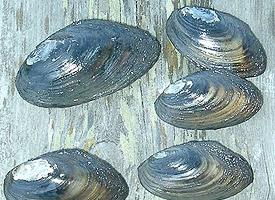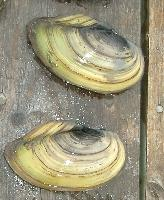
Popis zvířete
The Depressed River Mussel, scientifically known as Pseudanodonta complanata, is a fascinating and somewhat elusive species of freshwater mussel belonging to the family Unionidae. This species, primarily found in slow-moving rivers and streams across parts of Europe, has garnered attention due to its unique ecological requirements and the challenges it faces in the wild.Characterized by its relatively large, elongated shell, the Depressed River Mussel exhibits a somewhat flattened profile, from which its common name is derived. The shell's outer surface typically displays a range of colors, from dark brown to an olive green, often bearing growth lines that tell the tale of the mussel's age and the conditions it has endured. Inside, the shell is smoother and exhibits a nacreous, or pearlescent, quality that can range in color from silvery to a soft pink.
Adult mussels can reach a notable size, sometimes exceeding 10 centimeters in length, making them one of the larger species within their habitat. However, their size belies the fragility of their existence. The Depressed River Mussel has a complex life cycle that is intricately linked to the presence of specific fish species. In its larval stage, known as glochidia, the mussel must attach to the gills of a suitable host fish to develop properly. This parasitic phase is crucial for the mussel's growth and survival, highlighting the importance of biodiverse, healthy aquatic ecosystems for its continued existence.
The habitats preferred by the Depressed River Mussel are characterized by clean, well-oxygenated water with a moderate flow and a sandy or silty bottom. These conditions are vital for the mussel's survival, as they facilitate the mussel's unique method of feeding. Like many freshwater mussels, Pseudanodonta complanata is a filter feeder, drawing in water to extract oxygen and food particles such as plankton and detritus. This feeding behavior not only sustains the mussel but also contributes to the overall health of the aquatic ecosystem by purifying the water.
Despite its ecological importance, the Depressed River Mussel faces numerous threats that have led to a decline in its population across its natural range. Habitat destruction, pollution, and the alteration of river systems through damming and water extraction are significant challenges. Additionally, the decline in suitable host fish species due to overfishing and environmental degradation further exacerbates the mussel's plight.
Conservation efforts for the Depressed River Mussel involve habitat restoration, pollution control, and measures to protect and restore populations of host fish species. Given its role as a bioindicator, the health of Pseudanodonta complanata populations can provide valuable insight into the overall health of freshwater ecosystems.
In summary, the Depressed River Mussel is a species of significant ecological value, facing considerable challenges in the wild. Its survival is closely linked to the health of its aquatic habitat, making it a key species for conservation efforts aimed at preserving freshwater biodiversity and ecosystem health.
Podobná zvířata
Nové fotografie zvířat
Top 10 zvířat
- Dolphin gull (Leucophaeus scoresbii)
- Diana monkey (Cercopithecus diana)
- Moustached guenon (Cercopithecus cephus)
- Galápagos tortoise (Geochelone nigra complex)
- Japanese macaque (Macaca fuscata)
- Stone loach (Barbatula barbatula)
- Russian tortoise (Testudo horsfieldii)
- Greek tortoise (Testudo graeca)
- Common flying dragon (Draco volans)
- Vendace (Coregonus albula)


